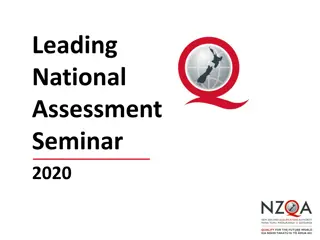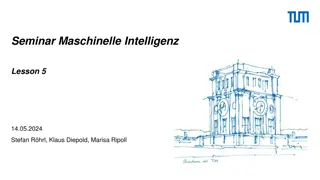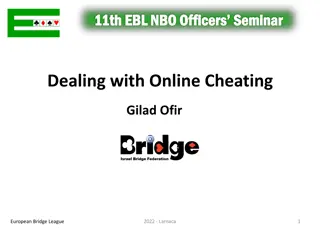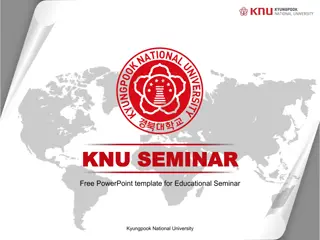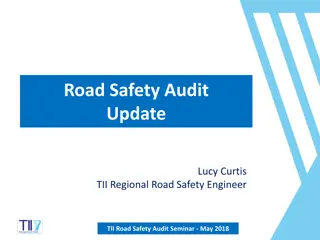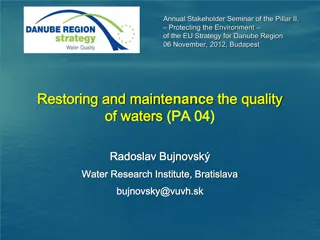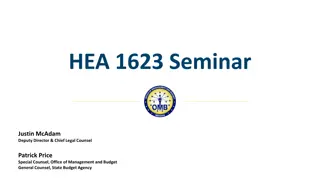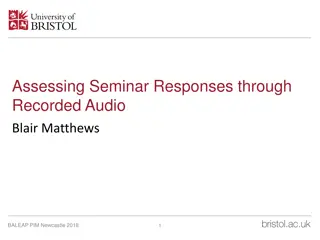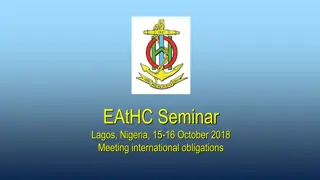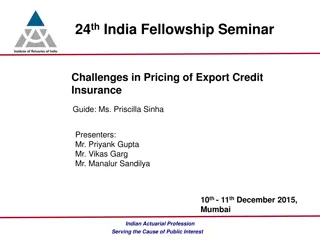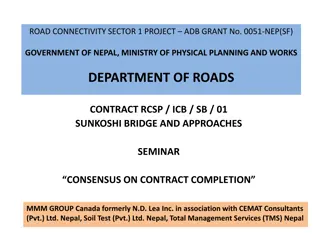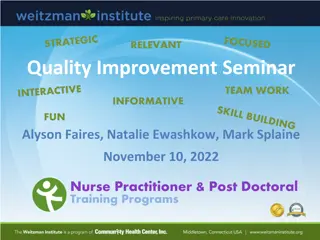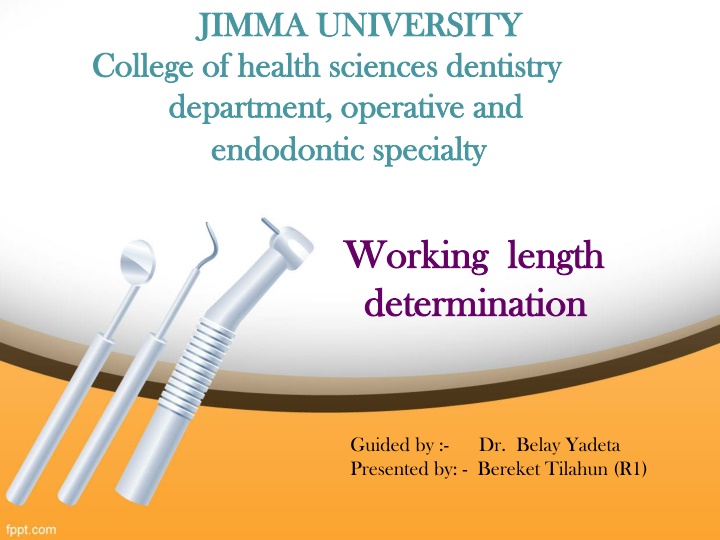
Working Length Determination in Endodontics
In endodontics, working length determination is crucial for precise canal preparation and obturation. This process ensures accurate instrument placement and limits the depth of canal filling, preventing post-operative issues. Learn about methods, terminology, and the significance of working length in this detailed guide presented by Jimma University's College of Health Sciences Dentistry Department.
Download Presentation

Please find below an Image/Link to download the presentation.
The content on the website is provided AS IS for your information and personal use only. It may not be sold, licensed, or shared on other websites without obtaining consent from the author. If you encounter any issues during the download, it is possible that the publisher has removed the file from their server.
You are allowed to download the files provided on this website for personal or commercial use, subject to the condition that they are used lawfully. All files are the property of their respective owners.
The content on the website is provided AS IS for your information and personal use only. It may not be sold, licensed, or shared on other websites without obtaining consent from the author.
E N D
Presentation Transcript
JIMMA UNIVERSITY JIMMA UNIVERSITY College of health sciences dentistry College of health sciences dentistry department, operative and department, operative and endodontic specialty endodontic specialty Working length Working length determination determination Guided by :- Presented by: - Bereket Tilahun (R1) Dr. Belay Yadeta
Contents Contents 1.Introduction 2. Terminology 3. Significance of working length 4. Methods of working length determination 5. Radiographic methods 6. Non radiographical methods 7. Classification of apex locators 8. Basic conditions for accuracy of EALS 9. Advantages of apex locators 10.Disadvantage of apex locators 11. Conclusion 12. References 11/10/2019 2
Introduction Introduction working length is defined as the distance from a coronal reference point to a point at which canal preparation and obturation should terminate . Determination of an accurate working length is one of the critical steps of endodontic therapy. Cleaning, shaping and obturation of the root canal can t be accomplished accurately unless the working length is determined precisely. 11/10/2019 3
Terminology Terminology Anatomic apex:- is tip or end of root determined morphologically. Radiographic apex:- is tip or end of root determined radio graphically. Cementodentinal junction:- is the region where cementum and dentin are united. 11/10/2019 4
Cont Cont Apical foramen:- the main apical opening of the root canal Frequently located eccentrically away from anatomic or radiographic apex. Apical constriction:- the apical portion of the root canal having narrowest diameter. Position vary but usually 0.5 to 1.0mm short of the apical foramen and have a funnel shape. 11/10/2019 5
Cont Cont Reference point:- it is a site on the occlusal or incisal surface from which measurements are made. This point is used through out canal preparation and obturation. A definite, repeatable plane of reference to an anatomic land mark on the tooth is necessary. Usually the incisor edge in anterior teeth, the cusp tip in posterior teeth. 11/10/2019 6
Significance of working length Significance of working length Determines how far into the canal the instruments are placed and worked. Limits the depth to which the canal filling may be placed. Failure to accurately determine and maintaining working length may result in length being over than normal which will lead to post operative pain, prolonged healing time and lower success rate. When working length is made short of apical constriction it may cause persistent discomfort because of incomplete cleaning, underfilling. 11/10/2019 7
Methods of working length determination Methods of working length determination Non Radiographical methods radiographical methods 11/10/2019 8
Radiographic methods Radiographic methods 1. 1. G Grossman s method rossman s method Grossman gave this formula for determining the correct length of the tooth CLT= KLI x ALT ALI Where, CLT= correct length of the tooth KLI= known length of the instrument in the tooth ALT= apparent length of the tooth on radiograph ALI= apparent length of the instrument on radiograph 11/10/2019 9
Cont Cont A, the length of the tooth is measured on diagnostic radiograph B, this measurement is transferred to a diagnostic instrument prepared with a silicon stop, the instrument is placed in the root canal and radiograph is made. C and D is the root canal and working length are determined from the radiograph. 11/10/2019 10
11/10/2019 11
Cont Cont 2. Ingle method 2. Ingle method Measure the tooth on the preoperative radiograph. Subtract at least 1.0 mm safety allowance for possible image distortion. Set the endodontic ruler at this tentative working length and adjust the stop on instrument at that level. Place the instrument in the canal until the stop is at the plane of reference. .11/10/2019 12
C Cont ont On the radiograph, measure the difference between the end of the instrument and the end of the root and add this amount to the original measured length the instrument extended in to the tooth From this adjusted length of tooth, subtract 1.0mm safety factor to conform with apical termination of the root canal at the apical constriction. Set the endodontic ruler at this new corrected length and readjust the stop on the exploring instrument. 11/10/2019 13
11/10/2019 14
Cont Cont 3. 3. weine s weine s modification modification Radiographically if there is no resorption of the root end or bone, shorten the length by 1.0mm. If periapical bone resorption is apparent, shorten by 1.5mm. If both root and bone resorption are apparent, shorten the length by 2.0mm. 11/10/2019 15
Cont Cont 4. 4. Xeroradiography Xeroradiography An electrostatic imaging system, that uses a uniformly charged x-ray sensitive selenium alloy photoreceptor plate in a light proof cassette. rapid imaging reduction in radiation larger area of bone greater degree of artifact 11/10/2019 16
Non Non radiographical radiographical methods methods 1. Digital tactile sense 1. Digital tactile sense Earlier method Appear to be very simple and its accuracy depend on sufficient experience The clinician should be able to feel the constriction by tactile sense. If the coronal portion is not constricted an experienced clinician may detect a resistance as the file approaches the apical 2 to 3mm. 11/10/2019 17
Cont Cont Drawbacks of this method include Difficulty in locating the apical constriction in teeth with immature apex and destroyed by resorption. Difficulty in locating the apical constriction in teeth which have constricted canal through out the length 11/10/2019 18
Cont Cont 2. Apical periodontal sensitivity 2. Apical periodontal sensitivity Determined by patient response to pain It is not an ideal method If the instrument is advanced in the canal toward inflamed tissue it cause moderate to severe pain. 11/10/2019 19
Cont Cont 3. Paper point measurement 3. Paper point measurement Gently pass the blunt end of a paper point into the canal after profound anesthesia. The moisture or blood on the portion of the paper point that passes beyond the apex is an estimation of the working length. This method may give an reliable data even if the pulp is not completely removed and more. 11/10/2019 20
Cont Cont Recently millimeter markings have been added to paper points. Have markings at 18,19,20,22 and 24mm from the tip and can be used to estimate the point at which the paper point passes out of the apex. 11/10/2019 21
Cont Cont 4. Electronic apex locator 4. Electronic apex locator Most important advancement in the recent decades An electronic device used in endodontics to locate the apical foramen, apical constriction and determine the length of the root canal space. 11/10/2019 22
Classification of apex locators Classification of apex locators 1st 2nd Generation Generation 3rd 4th Generation Generation 11/10/2019 23
Cont Cont 1 1st stgeneration apex locators generation apex locators Also known as resistance apex locator Measure opposition to the flow of direct current or resistance. When the tip of the reamer reaches the apex in the canal, the resistance value is 6.5 kilo-ohms(current 40mA). Often inaccurate results came up due to the presence of electrolytes, excessive moisture, exudate and blood. . 11/10/2019 24
11/10/2019 25
Cont Cont 2 2nd Also known as impedance apex locators Measure opposition to the flow of alternating current or impedance Uses the electronic mechanism that the highest impedance is at the apical constriction where impedance changes drastically. The disadvantage of second generation the root canal should have to be free of electro-conductive materials such as irrigants change the electrical characteristics and become inaccurate. ndgeneration apex locators generation apex locators 11/10/2019 26
11/10/2019 27
Cont Cont 3 3rd rdgeneration apex locators generation apex locators Also known as frequency dependent apex locators Introduced in 1990 similar to the 2nd but use multiple frequency to determine the distance. . They are based on the fact that different sites in canal give difference in impedance between high (8 kHz) and low(400Hz) frequencies. The difference in impedance is least in the coronal part of canal. 11/10/2019 28
11/10/2019 29
Cont Cont 4 4th thgeneration apex locators generation apex locators Recently fourth generation electronic apex locators have been developed which measure resistance and capacitance separately rather than the resultant impedance value. They have a built in electronic pulp tester. 11/10/2019 30
11/10/2019 31
Basic conditions for Basic conditions for accuracy of EALS accuracy of EALS Whatever is the generation of apex locator; there are some basic conditions, which ensure accuracy of their usage. 1. Canal should be free from most of the tissue and debris. 2. The apex locator works best in a relatively dry environment. But extremely dry canals may result in low readings, i.e. long working length. 3. If residual fluid is present in the canal, it should be of low conductivity value, so that it does not interfere the functioning of apex locator. 4. Canals should be free from any type of blockage, calcifications, etc. 5. Battery of apex locator and other connections should be proper. 11/10/2019 32
Advantages of apex locators Advantages of apex locators Device are mobile, light weight and easy to use. Much less time required. Additional radiation to the patient can be reduced( particularly in pregnancy). 80-97% accuracy observed 11/10/2019 33
Disadvantage of apex locators Disadvantage of apex locators Accuracy limited to mature root apices. Extensive periapical lesion can be give faulty readings. Weak batteries can affect accuracy. Can interfere with functioning of artificial cardiac pace maker- cautious use in such patients 11/10/2019 34
Conclusion Conclusion Modern apex locators can determine with accuracy greater than 90% but with some limitation. No individual method is truly satisfactory in determining endodontic working length. Therefore, combination of methods should be used to assess the accurate working length determination. 11/10/2019 35
References References John I. ingle & leif k. bakland; Endodontics I, 5th ed, Seattle, Washington; 2002 Nisha Garg & Amit Garg; Review of Endodontics and Operative Dentistry, new Delhi, India; 2008 B.suresh chandra & V. gopikrishna: Grossman s endodontic practice, 13th ed. India ; 2010 https://www.ncbi.nlm.nih.gov/pmc/articles/PMC4662761/ http://www.dentalhypotheses.com/article.asp?issn=215 58213;year=2014;volume=5;issue=3;spage=84;epage=97 ;aulast=Mosleh 11/10/2019 36
11/10/2019 37

